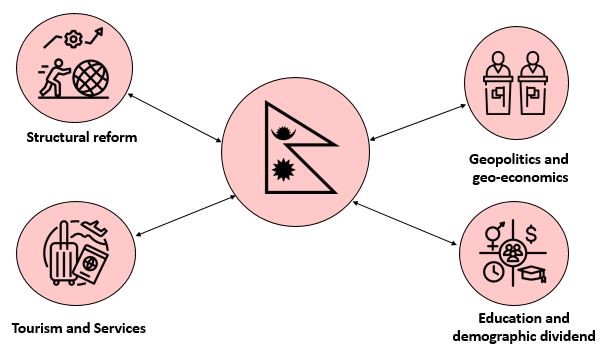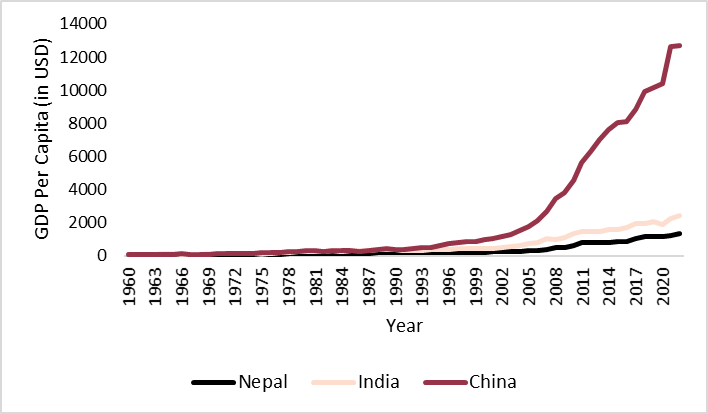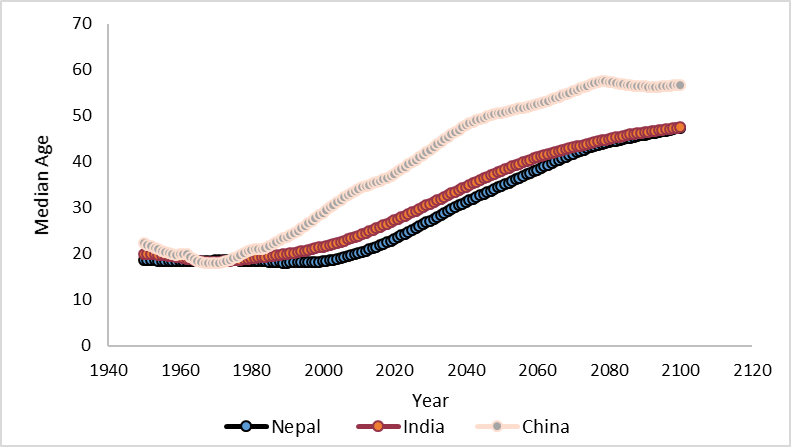What is the Global Economic Center of Gravity?
Amidst the historic shifts in economic powers, the global economy is undergoing a fascinating transformation. In 2011, Danny Quah, a renowned economics professor, conducted a study to pinpoint the center of gravity of the global economy. This insightful research revealed a remarkable trend: from its mid-Atlantic position in 1980, the global economic epicenter will shift between India and China (around Nepal) by 2050, signaling the rise of Asia and the East on the world stage. Although falling precisely at the center of economic gravity does not guarantee automatic benefits for a country, it is high time for Nepal to embrace and capitalize on this historic change in geo-economics.
However, crucial questions loom on the horizon. Moving forward, can Nepal adequately benefit from the rise of its neighbors while simultaneously addressing its socio-political challenges? How can Nepal strike a balance amid the entangling geopolitics? What consequences will the LDC graduation have for the development landscape of the country? Furthermore, can Nepal leverage its demographic dividend before it diminishes and fades away?
 Figure 1: Nepal and the global economy
Figure 1: Nepal and the global economy
The rise of neighbors
Nepal’s neighbors China and India now account for over 25% of the world’s GDP and 36% of the total population. These historically rich countries are finally regaining their global economic positions and are expected to surpass the US economy by 2075. This has given rise to the 21st century being the Asian century. In this emerging context, Nepal too has the opportunity to cash in on the economic comeback of its neighbors. Unfortunately, throughout its history as a nation-state, and particularly in recent decades, Nepal has been engulfed by frequent political, natural, and economic upheavals. In the past fifteen years, the nation has undergone ten changes in government, significantly impacting both policy formulation and political stability, resulting in an unfavorable business environment. Furthermore, detrimental events like the 10-year-long civil war, the royal massacre, and the 2015 mega earthquake pushed back the overall developmental progress of the country.
Figure 2: Comparison of GDP per capita of Nepal with India and China
Source: The World Bank
In this circumstance, it is obvious that Nepal’s GDP grew slowly compared to its faster-moving neighbors. As depicted in Figure 2, Nepal had an identical GDP per capita to its neighbors in the 1960s. India and China’s GDP substantially increased especially after the 1980s, thanks to globalization, liberalization, trade, and manufacturing boom. It is noticeable that China experienced exceptional GDP growth rates with double-digit growth as recently as 2007. Similarly, China’s GDP per capita overtook those of India and Nepal reaching over USD 12,000 as of 2020. On the other hand, Nepal only experienced its highest GDP growth rate of around 9% in 2017 but this growth could not be maintained beyond that year.
Moreover, Nepal closely resembled India’s growth trajectory because of the closely intertwined economies, facilitated by open borders, a pegged currency, and easy movement of people and goods. Since the 2000s, remittances have predominantly driven economic activity in Nepal, fueling imports and turning Nepal into a consumption-based economy, with a notably high consumption-to-GDP ratio of 94.2% and a remittances-to-GDP ratio of 22.8% as of 2022. A pivotal step for Nepal will involve transitioning from a consumption-based economy to a production-led one to align itself with the growth of its neighboring countries.
Navigating geopolitics and geo-economics
Another important aspect for Nepal will be to navigate shifting power dynamics, not just between neighboring countries but also among influential powers like the US and UK. With the shift in global economic hubs to Asia particularly into China and India, Nepal may foresee an increase in instances of both soft and hard influences. This was witnessed in the US’s Millennium Challenge Corporation (MCC) countering China’s Belt and Road Initiative in Nepal through infrastructure projects. Similarly, Nepal has been facing and might face different geo-economical interventions such as the economic blockade, and export ban by India. In terms of development aid and foreign investment, geopolitics will remain prime for Nepal as witnessed in the competing investment commitments made by India and China in the recent Nepal Investment Summit 2024. Likewise, foreign aid though vital for Nepal’s development, has historically been used for geopolitical and diplomatic motives of the donor countries. Therefore, in the coming decades, Nepal has to intricately balance the hard and soft power play between India, China, and the US while avoiding the brunt of great power politics that small countries often face.
Managing dwindling demographic dividend
Demography will be the make-or-break factor for Nepal’s future economy. As per UNICEF’s research, Nepal is projected to enter the category of an aging society by approximately 2028, and it is expected to transition to an aged society by around 2054. Moreover, Nepal will have a small demographic window of opportunity of approximately 50 years to capitalize on its youth making it one of the fastest aging transitions globally. This has created a vexing issue for policymakers, experts, and citizens alike regarding whether the country will get old before it gets rich.
Figure 3: Comparison of median ages of Nepal, India, and China
Source: United Nations Population Division, Department of Economic and Social Affairs
Figure 3 illustrates the actual and forecasted median age of Nepal, India, and China for 150 years from 1950 to 2100. It is noticeable that the median ages of both India and Nepal will be around 47 years while China’s will reach around 56 years in the year 2100. This means technically Nepal has around seven decades before it loses the current majority of the youth population required for fueling economic growth.
Amidst the challenges posed by the demographics, a new hope arises from the expanding global Nepali diaspora resulting from a series of migrations over the years. The Nepali diaspora have been increasingly positive given their rise to influential positions in global companies and a deep concern for the future of their home country. For instance, Nepalis in the US have established international firms like Fusemachines. Moreover, Nepal can capitalize on returnee and transnational entrepreneurs. In countries like China, India, and Mexico, these entrepreneurs have been instrumental in the propelling development having started a new venture after studying or working abroad. Research has shown that these entrepreneurs contributed immensely to globalization, export promotion, and high-tech innovations in China through brain gain.
LDC graduation and need for structural transformation
A major milestone in Nepal’s developmental journey will be the graduation from a Least Developed Country (LDC) post-2026. With this entry into a new phase, Nepal needs to recalibrate its focus from aid dependency to services trade and investments. For instance, Nepal has shown great potential for IT exports with earnings worth around USD 515 million in 2022, a 64.2% increase from the previous year. Similarly, tourism can be another game-changer contributing to foreign reserves, job creation, and overall economic growth.
In terms of structural transformation, although Nepal has experienced static reallocation with a shift of labor from traditional to productive sectors, it has neither created large-scale quality employment nor achieved sustained growth. Thus, as a land-locked country with a limited industrial base, Nepal direly requires another structural reform, particularly in areas including digitalization, education, and governance.
Way ahead
The upcoming decades will be crucial for Nepal, as it aims to become an upper middle-income country and witness the pinnacle of development in its neighborhood and the region. Against this backdrop, Nepal faces significant decisions, including drawing inspiration from regional development, navigating geopolitical shifts, and managing changes in its demographic dividend. However, the lingering question remains whether Nepal will timely address these strategic issues or be a passive observer amid the rapid socio-economic changes in and around it.
Sagar Jung Karki works as beed at beed management, having previously interned at the Institute for Integrated Development Studies (IIDS). His core areas of interest include international business, trade, entrepreneurship, and digitalization. He holds an MSc in International Business from the University of the West of England. As a global-minded individual, Sagar aspires to become a pracademic, contributing positively to the world.







